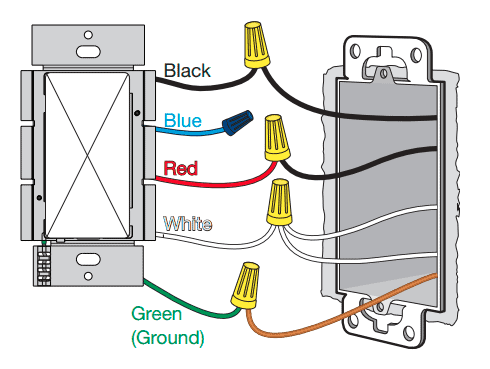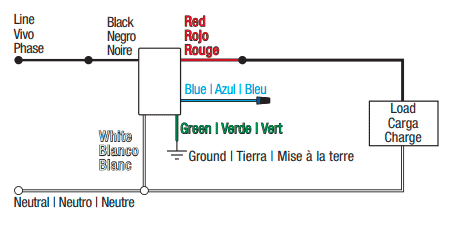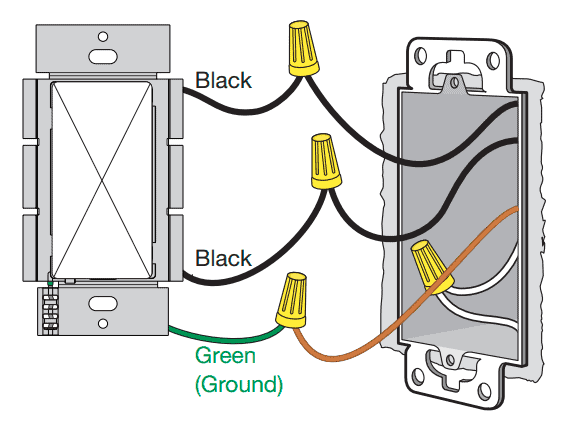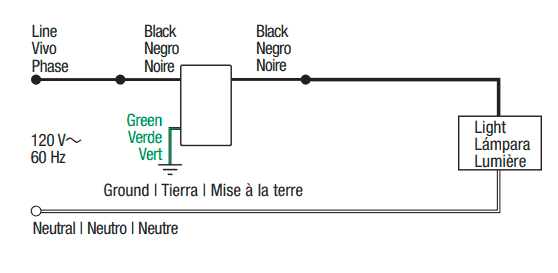Smart light switches seem a bit of a contradiction when you first think about them, because an electrical switch has two states: on or off. But yet, any smart devices must always be ‘on’ in order for it to be smartly controlled. So how does a smart light switch stay ‘aware’ (and ultimately powered on) even when switched off?
Smart switches with a neutral wire readily power themselves from the hot and neutral line, whereas switches without a neutral take a trickle of power from the supply to the bulb – slightly lighting them in the process.
Do Smart Switches Use Electricity When Off – How smart switches generally work

Lutron Caseta.
Smart light switches are a useful invention and some people prefer them to smart bulbs, because they allow you to turn lights on and off in a room in a fairly natural way.
Smart switches are wired into your house’s electrics, replacing a room’s existing light switch. Therefore they can ultimately only control the smart light bulbs that the switch previously controlled (unlike smart light bulbs which can be independently managed as long as power is flowing to them).
Due to this, smart switches are great for many ‘utility’ or ‘task’ based rooms, such as kitchens, utility rooms and bathrooms because you’re likely to just want the lights on or off in these rooms. Smart switches are perfect for this, especially since some models have motion sensors built into them which automatically turn the lights on as you walk into these rooms.
Once they’re wired into your house, smart switches draw electrical power (more on this later), and then use a communication protocol to ‘speak to’ a central hub, allowing you to use a smartphone app or a smart speaker to turn the switch (and hence lights) on and off.
This ‘communication protocol’ is usually WiFi, meaning that the smart switch connects to your home’s network just like your TV, phone and other devices do. The switches can then be communicated with (securely) over the internet.
Alternatively, smart switches can sometimes use different communication protocols such as ZigBee and Z-wave, which use a bit less electrical power and can be more reliable than WiFi.
Either way, the main thing to know is that a smart switch has to draw some power (with or without a neutral wire) so that it can be smartly managed via your app or a smart speaker. The two following sections look at this in more detail.
Smart switches with a neutral wire
The majority of the smart switches on the market require a neutral wire, and this is because any American houses built from the 1980s onwards should have a neutral (white) cable running into smart light switch back boxes.
In this way, smart switches are wired in between neutral and supply-hot and thus will draw power in the usual way.
For example, if you have a dimmer switch with one black, red, white, blue and green cable, the resulting cabling for a Lutron Caseta dimmer would look like this:

A more technical wiring diagram is below:

As can be seen, the smart switch’s own electrics can readily draw power as needed from the supply-hot line and the neutral line.
In this configuration, the smart switch will control the power to the light via the load-hot (red) wire. Only when the switch is turned on (either physically, or via the smart functionality) will the circuit be complete and the power will flow to the light.
Otherwise the electrical circuit is broken, and the light doesn’t come on.
Smart switches without a neutral
The above wiring diagram is fairly typical of modern American houses, and much of Europe (whose switches and sockets have had neutrals for a while)
But whenever a neutral wire doesn’t exist, a simple 2-wire circuit is used to power a light. Hot and ground go into the switch, and the hot – called the supply-hot – is a permanent live feed from the house’s mains power.

The switch then runs another hot cable – called the load hot or switch leg wire – to the light fitting. The switch completes the circuit: when it’s on, the circuit is complete and the load-hot supplies live power to the bulb – turning it on.
When the switch is off, the circuit is broken and no power flows. This works fine overall, but it causes problems for smart switches which have to have their own (small) power supplied to it in order for the smart functionality to work.
Since there’s no neutral to draw power off, instead the smart switch is installed in series with the smart light bulb:

The difficulty here is that the load line isn’t designed to power the smart switch too, and so the smart switch needs to ‘steal’ (or leak) some power from the bulb.
This is done by making use of the dimming feature of the switch/bulb, and it draws down a small trickle of power through the live load cable. This is a bit of a ‘clever hack’, and whilst it’s safe, it has a few main drawbacks:
- Depending on how much load can be drawn to power the smart parts of the switch, a load resistor is sometimes needed to help enable the current leakage.
- Since this makes use of dimming features to work, both the smart switch and the fitted bulb must usually support dimming. You’ll usually find that smart switches which support dimming are more expensive, too – in other words, a smart switch without a neutral is probably going to be more expensive than one which doesn’t require a neutral.
- It’s rare that LED smart light bulbs (both normal ones, and smart ones) can be used in smart switches that don’t need a neutral. This is because the trickle of power through the load can cause issues with LED bulbs, and often such switches only work with outdated incandescent bulbs.
In short, smart switches that don’t require a neutral fill an important part of the market (i.e. the majority of pre-1980s American homes!), but they also rely on some necessary ‘hacks’ to power their smart functionality, and this comes with some limitations.
Increased energy use from smart switches
If you’re wondering how much energy or extra power smart light switches consume (since they’re always on), you probably don’t have to worry much!
If the smart switch uses ZigBee, Z-wave or a radio based approach (such as Lutron’s non-smart RadioRA 2 technology), you’re probably looking at a power draw of around 0.2-0.5W max:
- RadioRA 2 uses 0.2W of power.
- Whereas a Aeotec Z-wave switch was measured at 0.4W idle.
Having said that, the most common smart switch communication protocol nowadays is WiFi, and this is more power intensive. But don’t worry – even with WiFi, the smart switch will only use around 1-2 watts of energy consumption – a similar amount to a smart plug (this page mentions that a WeMo smart plug uses 1.5W of energy, for example).
In short, a smart switch will use more energy than a standard (dumb) switch, but no more than 2W of energy at idle for a WiFi switch and less than 0.5W at idle for a ZigBee/Z-wave switch.

Excellent information! I just installed a Lutron Sunnata dimmer and was wondering how its “electronics and the low light “off” LED indicator” were functioning even though there was no return path neutral wire connected to the switch.
Thanks! Yes it’s quite interesting how they work without a neutral return.
Can I steal a connection from another single wire switch in the same box?
Nowadays, a capacitor is placed in parallel with the lights to act as a load. The light bulb do not need to support dimming feature. You might want to update the article above.
It is very common for higher power LED bulbs to work with Zigbee based switches. Wifi type non neutral switches require a capacitor installed at the light bulb to work as a load.
Thanks for the extra knowledge Twc, that’s good to know.
As a suggestion, either add to article or a new one discussing energy savings from having the light(s) dimmed.
Thank David, yes this will be a good one to cover. I’ll make a note of it.
I believe it is worth highlighting a significant potential (no pun intended) safety issue with Smart Switches that do not use a neutral connection in that the bulb socket is effectively ALWAYS live (unless the entire circuit is isolated at the fuse box / consumer unit).
Hi David, thanks for that, yes you’re completely right. I need to update the article on a few safety points in due course, and will ensure this is flagged up. Thanks for the helpful comment – it’s definitely a downside of ‘no neutral’ smart switches.
I’ve been searching everywhere for a switch to use with smart lights. I have Tuya products and it would be great if Tuya had a hard-wired smart switch that could be programmed to its smart lights but I don’t think they do. The alternative would be a switch with a small toggle switch to control the constant to the load like a normal switch and larger smart toggle switches to connect to the smart lights. The constant/load switch would barely be used. The reason I figure that I would need it is for programming of the connected smart lights in case power goes out and the smart light needs to be reconnected/programmed. Then the smart switches would be used to control the smart lights in the traditional way if someone chooses not to use voice or app control. If anyone knows of anything that could help me out please let me know.
I have a old mercury thermostat that I would like to have turned on/off remotely to control a wood pellet stove. New digital thermostats don’t work because of a epa requirement to have a non-starting sequence that cycles to the stove when it doesn’t heat fast enough. What is the wiring diagram to keep power out of the thermostat?
Good question – unfortunately I’m not 100% sure, and I wouldn’t want to lead you astray. Your comment should appear publicly now, and hopefully someone else knows for sure.
I was looking for the smart device power consumption. Can you confirm your watts consumed are per hour? Also is there a two speed smart switch available. I have a house fan with a smart switch wired to the two speed switch. Thus, I can only turn fan on and off in the speed set by the manual two speed switch. Have not found a solution so far in internet searches.
I barely see any power consumption (i.e. below 1-2 watts) when a smart switch is off (i.e. not actively supplying power to the bulb). Regarding your other question – unfortunately I’m not aware of any two-speed switches either. I agree that this would be really useful though. Your comment should now be visible, though, so hopefully others will reply if they know of such a product.
Hi Tristan, A very useful article. Am from Australia and contemplating opting for smart switches in the entire house as a way of cheap automation. As a layman this is my understanding. If I have a smart switch, I need to keep turn it on always (unsure I am correct or wrong) and say in a living hall, I am having normal downlights (not smart) and ceiling fans (not smart) and I connect all the down lights and fan to this smart with (neutral wire based), I can through my mobile or voice control can turn on the switch and hence all these bulbs and fans work and when I turn off the switch all will not. Based on this logic, I assume instead of spending to buy each smart bulb and smart fan, I can just pay for one smart switch. Am I missing some thing here? Are they any specific advantages of having a smart downlight or smart fan that wont be achieved with smart switch that controls them. For your information, am contemplating of using the smart switches from this Australian company. You can easily see the product specs if requiredhttps://www.ikuu.com.au/products/trade/switches/
Only thing I wanted to confirm is, AM I CORRECT to just pay for one smart switch board in each room instead of spending on each smart bulb, fans in a room
Thanks in advance for your feedback.
Hi Naga,
Thanks for the comment, and you’re completely right in your thinking. The benefit of a smart switch is indeed that you can control all the bulbs/fans that it is physically (electrically) wired up too, without needing to buy individual smart bulbs.
For example, I have a switch that powers 12 GU10 downlights. If I wanted smart control here, I could either purchase a single smart switch, or 12 smart downlights – naturally the former would be a much cheaper option! However the benefit of smart downlights is that I could then dim down the brightness, and also change their color (assuming I purchased color downlights). So with smart bulbs, I could have a disco or create chilled out lighting effects – this isn’t possible with just a smart switch.
But if you only want smart on/off control, a smart switch will definitely work best for you. It will be cheaper and less hassle than trying to manage loads of smart lights as a single grouping.
Hope that makes sense and helps!
Tristan